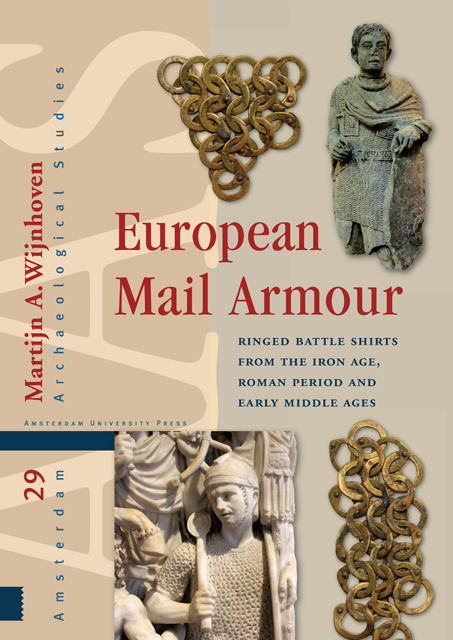Book contents
- Frontmatter
- Contents
- Acknowledgements
- Dedication
- 1 Introduction
- 2 The origins of mail armour
- 3 Distribution and archaeological context
- 4 The iconography of early mail armour
- 5 The naming of mail armour
- 6 Decoration in mail garments
- 7 Padded garments
- 8 The craft of making mail rings
- 9 Weaving patterns
- 10 The construction of mail garments
- 11 Ring characteristics
- 12 Final considerations
- Bibliography
- Database
- Appendix 1 Catalogue of mail armour
- Appendix 2 Catalogue of hybrid armour
- Appendix 3 Catalogue of isolated finds of fasteners and fixtures
- Appendix 4 Finds excluded from the database
8 - The craft of making mail rings
Published online by Cambridge University Press: 24 November 2022
- Frontmatter
- Contents
- Acknowledgements
- Dedication
- 1 Introduction
- 2 The origins of mail armour
- 3 Distribution and archaeological context
- 4 The iconography of early mail armour
- 5 The naming of mail armour
- 6 Decoration in mail garments
- 7 Padded garments
- 8 The craft of making mail rings
- 9 Weaving patterns
- 10 The construction of mail garments
- 11 Ring characteristics
- 12 Final considerations
- Bibliography
- Database
- Appendix 1 Catalogue of mail armour
- Appendix 2 Catalogue of hybrid armour
- Appendix 3 Catalogue of isolated finds of fasteners and fixtures
- Appendix 4 Finds excluded from the database
Summary
‘The iron armour concerned, does not consist of such iron scales and pieces, but rather of thousands of small rings, which are thus tightly woven and fastened in one another, so that they protect against the more nimble guns and withstand and stop smaller bullets that bounce off from them. In this manner and of such work, armoured caps, coats and shirts, with or without sleeves, gloves, trousers, stockings and all types of clothing are made, likewise objects hanging from the body such as belts and pouches.’
Christopher Weigel, Book of trades
The concept of chaîne opératoire, as a methodological tool for analysing the technical steps of mail making within a socio-cultural context (chapter 1), is at the heart of this chapter and those that follow. This particular chapter focusses upon the rings that make up a mail garment. These usually consist of riveted and solid rings. The riveted rings are made by shaping metal wire into a circle with overlapping ends that are subsequently pierced and sealed by a small rivet. The solid rings are punched out of sheet metal or made by welding a wire ring shut. The subsequent chapter will look at the manner in which the rings were woven together into a mesh, while chapter 10 discusses the different techniques the mail maker employed to tailor a garment. Finally, chapter 11 focuses upon the small characteristics of mail rings as a possible indicator of age and provenance.
THE MAIL MAKER‘S PROCESS
Contrary to what one might expect, written sources describing the manufacture of mail are conspicuously lacking. As is often the case with traditional crafts, the ancestral knowledge and skills required for the fabrication of mail were probably transmitted orally from master to apprentice. Formal texts of the craftsman's work process as a learning aid seem to be a recent development, likely related to institutional education. Perhaps for this reason, there are no texts or handbooks explaining the production of mail armour from antiquity.
There are few written mentions of the production of armour in general. The Notitia dignitatum is a text written during the Late Roman period which details the administrative organisation of the Western and Eastern Empire.
- Type
- Chapter
- Information
- European Mail ArmourRinged Battle Shirts from the Iron Age, Roman Period and Early Middle Ages, pp. 183 - 210Publisher: Amsterdam University PressPrint publication year: 2021



